#who also used wire and materials like that to create kinetic sculptures
Text
You could totally tell David smith was a Pisces lmao wow
#working on an assignment about him and his sculptures#and fuck I just wanna add#this man was such a Pisces you could feel and see and hear it so distinctly#good for him we love that for him#LMAO am I on crack . yea#no but I’m right. I’m so right. you could tell!#he was so well and quietly spoken and thought-out when it came to his art#he knew his likes and dislikes#and what worked for him and didn’t work#and utilized everything he knew to create such elegant sculptures out of such a harsh material#that back then had super /strong/ associations with it - being commonly used in industrial and commercial means#his work feels so elegant to me because of how he was able to transform it into such a delicate and artistic thing#I’m too tired to properly flesh out my thoughts#but wow!!!! really like his work 0.0 it also reminds me of Alexander Calder - another artist that I really like#who also used wire and materials like that to create kinetic sculptures#just…. wild man!!! completely wild!#i gotta get back on my grind lol and make more kinetic work and sculptures#so inspired now and reminiscing on my 3d design class. that was such a fun time honestly#i wanna go back and spend more time with my old professor#Professor I miss youuuuu
0 notes
Photo
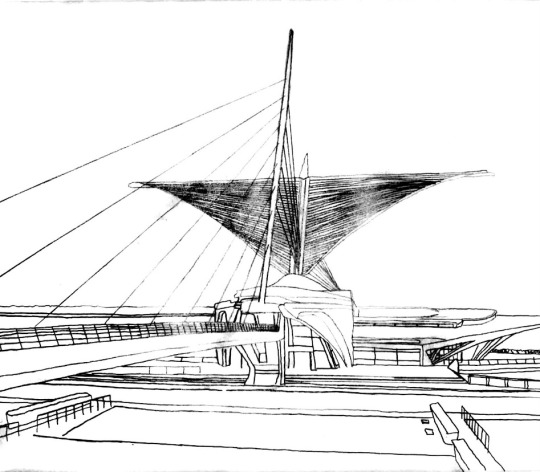
Week 3 - One Piece At a Time
For this assignment students were to visit the Milwaukee Art Museum and find a piece of design that was 3-Dimensional and was functional. I study architecture at the University of Wisconsin - Milwaukee and thought it would be appropriate to choose the art museum itself. The Milwaukee Art Museum is an architectural landmark, especially for Milwaukee. It is comprised of three buildings designed by Eero Saarinen, David Kahler, and Santiago Calatrava. With a collection of over 25,000 works, the Milwaukee Art Museum is one of the largest museums in the country. The galleries feature everything from folk art to contemporary American, all from diverse disciplines like prints, sculptures, and paintings. The “wings” portion is called the Quadracci Pavilion, and is the iconic addition to the art museum, designed by the Spanish/ Swiss architect Santiago Calatrava. Born in 1951, Santiago is a world renowned architect who is particularly known for his bridges supported by single leaning pylons, and his railway stations, stadiums, and museums, whose architectural sculptural forms often resemble living organisms. The Milwaukee Art museum was Calatrava’s first building in the United States, and his first museum. It was an addition to an existing building which was also designed previously by architects, but this time there was more freedom of form and architectural theatrics. In 1981, Calatrava established his own architecture and engineering firm in Zürich. Completed in 2001, the museum is able to change the amount of light it receives in its main cathedral-like lobby area with a vaulted 90-foot-high glass ceiling. The pavilion is a movable sunscreen with a 217-foot wide wingspan which unfolds and folds twice daily. The supports that connect to the pavilion also connect to the pedestrian “Reiman Bridge,'' which connects the museum to the city. The design of the structure is inspired by nature and presents a combination of organic forms and technological innovation. The expansion incorporates multiple elements which takes the location facing the lake into consideration. The structure is made of steel blinds which silhouettes the wings of a bird, and attached is a wired pedestrian bridge with a raised mast inspired by the shape of a sailboat and a curved gallery of a single floor reminiscent of a wave. The pavilion also includes kinetic structure, or a brise-soleil, which is an architectural feature of a building that reduces heat gain within that building by deflecting sunlight. When it is open, the form also becomes a sign, against the bottom of the lake, to announce new exhibitions. Cutting edge technology and traditional crafts were dedicated to creating the structure of the stylish building, which is mostly built from pouring concrete into wood shapes as a mold and combining it with steel and glass. According to the engineers, the sculptural form of the structure lent itself to the use of reinforced concrete, a material characterized by its fluid and doable qualities.
“... Instead of just adding something to existing buildings, I also wanted to add something to the front of the lake. Therefore, I have worked to infuse the building with a certain sensitivity to the culture of the lake: ships, sails and ever changing landscape…” - Santiago Calatrava
Based on the design thinking methodologies taught in class, and from studying architecture and art for the past four years, I would say the Milwaukee Art Museum is a staple in the city. Milwaukee is known for this building, and is a strong architectural statement that sets an architectural standard. The building is designed so it is full of windows that give off a lantern glow on the downtown lakefront, radiating light in all directions. I’ve visited this building on multiple occasions with friends and family, each time learning something new about either the building or the works of art inside. Studying architecture in Milwaukee is very exciting, but it is particularly more exciting at the museum considering the architect, location, and program. I’ve never seen anything like it besides from the same architect, Santiago Calatrava. Using knowledge of engineering to create innovative, sculptural structures is often overlooked by the masses. His ability to use nature as inspiration which reflects in the natural shapes and rhythms. This building in particular looks like a bird, a famous animal which partially lives on the lakes in Wisconsin. Combining thermal control with design is crucial to architectural design. Since the pavilion has a purpose, it becomes less of an art piece and more of a design, but is still beautiful.
0 notes
Photo
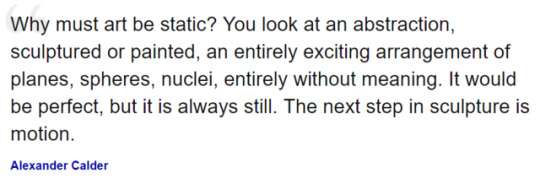
Final Analysis
Alexander Calder’s work is incredibly captivating, and it drew me in from the beginning, with the use of shapes, movement, and colour. I knew that it would work extremely well in a game environment. My next task was to come up with the story for my level, as it’s supposed to convey the style of the artist, as well as the meaning behind their work, all while making it appealing to those who had no idea about the artists work. After researching Calder and his work, I found that despite his medium of sheet metal and wire, he created a lot of pieces with titles inspired by nature, and the real world, such as his kinetic sculptures “Tree”, “Snowflakes”, and his “Animobiles”. This immediately got me thinking about the contrast between the materials and the conveyed image his sculptures create, and I really wanted to have that be the focus of my game.
Of course, by choosing Calder, I had signed up to create a level that absolutely had to move, just like his entrancing mobiles. This gave me the idea to bounce off of what he’d created with his “Tree” sculpture, and create a whole abstract forest, including the wild animals, the moving tree branches, flowers etc. And to push the whole idea of balance that Calder was very invested in, I decided to have the whole forest balanced on a huge mobile. I set to work creating the models in Maya, starting with the trees, and did a lot of research into how to best create animation and transport it into Unreal. While animating, I watched videos of how real tree branches moved, as well as videos of Calder’s actual sculptures. In the end, I think the trees turned out to be almost hypnotic in the way that the branches turned and swayed, exactly like Calder’s mobiles.
I created the mountains in the level after looking at Calder’s lesser known 2D paintings, which also inspired the flowers that I created and dotted about the level too. Something that was really important to me was the sky mobile, which was actually really hard to make, as the model has multiple moving parts, and required two animated joints, and weight painting in Maya. I almost gave up on it, but I’m glad I didn’t, as it creates this perfect paradox of a natural thing like the moon being made out of man-made materials. The final thing I modelled were the animals, which I really loved creating. Calder actually creates a lot of animal sculptures, and I really think they bring the whole environment together, as well as drawing people in more, which is what the brief was asking for.
If I were to do anything different, I would have definitely looked into my texturing more. Looking back at my level, although Calder’s work doesn’t have much texture, and it’s very much reliant on colour, a normal map on things like the mountains would have tied them into the scene a bit more. I also would have added some more polygons to models like the sky mobile, which has some large ridges that I dislike. I think I was so afraid of things going wrong with importing high poly models into Unreal Engine, I sacrificed some of the quality of my work. But I think of it as a learning experience, and now I know that the software isn’t as delicate as I thought it would be.
0 notes
Text
Analogue to digital- Emma Moser
Reflection and Process
Being assigned to walk around campus for an hour collecting trash was an interesting introduction to this workshop. As I walked through the campus it lead me to discovering places I didn’t even know existed including buildings and hidden seating areas. I also found a shift in my attitude towards litter as I would usually frown upon spotting trash on the ground, however I felt myself become excited as I was able to collect it as it served purpose to me now. After returning back to the group we discussed what we found, some unusual objects included nerf gun bullets, earphones and a stylus. We also realised that most of the litter we found was material that we only use for a short amount of times, this disposability proves our addiction to plastic and the harm we are causing to our planet.
I then begun the process of recording and archiving my material by photographing it on black and white background, scanning and photocopying the items.

Learning about composition and instantly applying that knowledge by creating a collage out of the photocopies of our waste items was a challenging thought process as I attempted to create a composition using the techniques I just learnt including kinetic sequencing, a visual hierarchy and repetition. After photocopying a print of this collage I begun the fascinating analogue process of creating a photo release print. I loved this process as the materials were so simple and it created such a lovely print effect.
Moving into the digital part of this module was when I begun leaving my creative comfort zone, as I have extremely limited experience on both Adobe Illustrator and Photoshop, I initially spent a lot of my time fiddling and trial-and-erroring features on the program in order to develop a better feel and understanding of what I was doing. Creating a library of assets on illustrator of my scanned litter was interesting as I was able to witness a real life object transition into a digital image. After playing around with the image trace feature I as able to develop a library of assets.
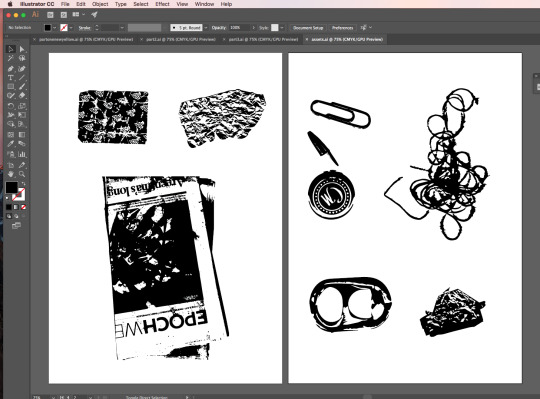
I then begun experimenting with colour and creating a vector illustration, referring back to my composition knowledge. From the outset of creating these compositions I was fascinated in circular type visual paths and I further explored this in these illustrations. I decided on using the can pull, paper clips and glass bottle cap images to create a three part continuous series which features a visual path that travels through the three panels. The circular formations combined with the visual path and bleeding is aimed to represent the almost limitless quantity of these small items we have in this word, and how they can end up as litter in our environment. I originally experimented with complimentary colours and used a different set of three colours in each panel.

However, I decided to simplify the colour palette and chose three colours for the entire series as this was more pleasant and easy to look at.

Final Reflection
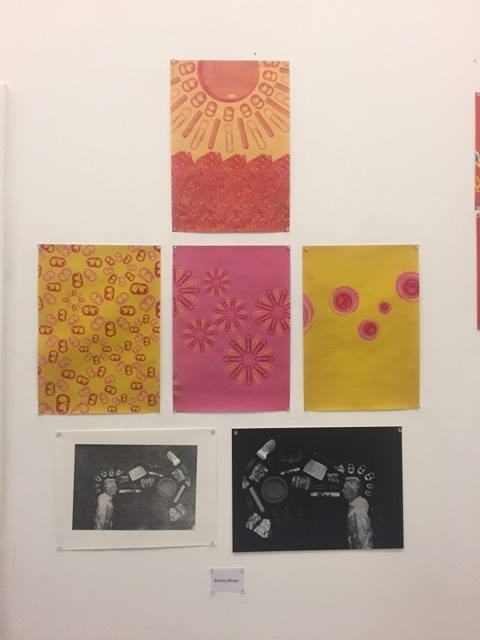
It was incredibly fascinating and confronting to see how quickly I was able to turn a physical pile of rubbish into a series of beautiful visual works through a variety of different processes. At times the process was frustrating and confusing as I’m so new to using programs such as Illustrator and Photoshop, however it opened me up to a whole new area of visual design and allowed me to learn new skills, making these programs less intimidating. As a more analogue type artist, I was really happy with the results of the photo release printing using citro-clean and this is a process I would really love to explore again in my art making. I mistake I feel I made was not opening my mind enough to the array of different kinds of compositions and techniques I could of used in my work, this could of been improved with more time to experiment and further research on designers that create a wide range of compositions.
Overall, this workshop really supported the idiom “one man’s trash is another man’s treasure”, and I thoroughly enjoyed the entire process.
Research
Alison McDonald is an environmental artist from Townsville. Due to the fact that McDonald lived outside the curb-side garbage collection system when she was growing up, she was raised dealing with her own waste and learnt how to be a recycler. This combined with the artistic influence of environmental sculptors such as Andy Goldsworthy resulted in Alison McDonald having a heavily influential and thought-provoking art practice, highlighting issues which concern the way we use and waste material, and the long-term impacts this leaves on our environment.
McDonalds work A Retribution of Rubbish is a sculpture of three jellyfish constructed out of plastic bottles, fishing line, wire and electrical ties. The bottles give a life-like milky, translucent quality that you see in jellyfish and the realistic illusion is extended as the breeze causes the sculpture to freely sway, making the jellyfish come alive. McDonald uses the beauty in her artwork to encourage her audience to consider the relationship between rubbish and the environment, specifically how plastic debris has filled the ocean and shorelines worldwide, causing harm to marine life.
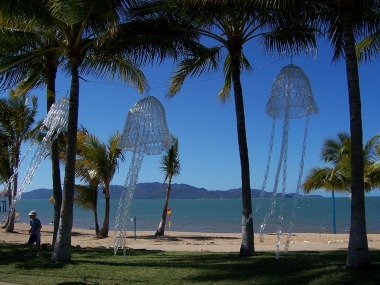
A Retribution of Rubbish, 2005. PET plastic bottles, nylon fishing line, wire, and electrical ties, 500 x 140cm.
McDonald later created a work titled Just A Drop, which was a construction made out of many plastic water bottles, forming the shape of a water drop. The work heeds a warning, and encourages further investigation into societys flawed methods of water consumption. Currently, water bottles are known as a convenient way to stay hydrated, however, the amount of effort put into the design, sourcing, manufacturing, filling, shipping and refrigerating is often overlooked by consumers. She further expresses her issues by describing bottled water as “a criminal thing… more expensive than petrol.” As the average cost of a litre of tap water is $0.001 as opposed to $2.83 for bottled water, which is much more costly compared to the average $1.45 for petrol. This raises questions as to why us as a society so willingly waste money of such a pointless and harmful product, as these bottles so often end up in the ocean, damaging the environment.
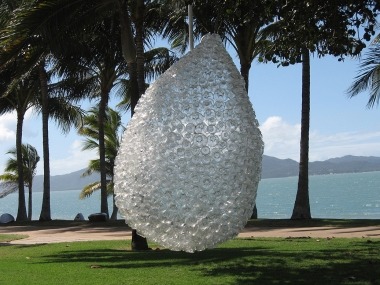
Just a Drop, 2007. PET Bottles and cable ties, 200 x 110cm.
Aurora Robson is a Canadian-American artist who initially was a painter, basing her works around reoccurring nightmares she had. One day while working in her studio she was distracted by the bright sunlight that was reflecting off plastic bottles dumped on the street, she noticed a similarity between this visual and her own paintings and wondered if she could create sculptures out of this “nightmare debris”. She begun learning about plastic as a polluting material and found that working with it enabled her to transform a horrible thing into something much more pleasant and wonderful, on both a personal level, in reference to her nightmares that commonly influence her work, to a much broader audience, highlighting the issue of society’s use of plastic and heavy volume of waste producing. Robson found that creating sculptures out of waste gave the audience a chance to reflect their behavior and relationship to matter and material that they interact with daily.
She then went on to further explore this art practice by creating Project Vortex- an international group of artists and designers who intercept the waste stream through their work, they work with water clean-up organisations to collect debris to use in art, and the proceeds of these sold works support the continuation of river, shoreline and ocean clean-ups.
Aurora Robson was invited to Hawaii to create a sculpture as a part of the Waimea Ocean Film Festival, as she went to the local shorelines to collect material, she was shocked by the amount of litter that has settled on the beaches, describing it as “the ocean literally spitting up material”, she also noticed that this debris has travelled from all over the world. Noting that this is a global problem, Robson is confident that art is a global language that can be used to help people recognize how much power they have in the choices they make as consumers and individuals. She also believes that she has only scratched the surface of what she can do to interrupt the waste stream through her artistic practice.
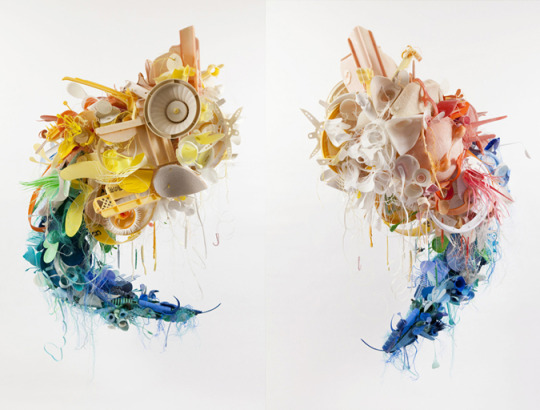
Camilo, 2011, Plastic marine debris
Chris Jordan is an artist and photographer from Seattle. Many of his works are photographs of garbage and the results of mass consumption in America. His photograph series: Intolerable Beauty: Portraits of American Mass Consumption (2003-2005) is a close exploration of this issue as it draws attention to the unconscious behaviours in our everyday lives and the ugly consequences of our habits. Jordan conveys these messages through his photographic techniques and his use of compostion is a strength in his work.
One of the photographs in this series, Wall Of Drums, has a strong visual message of the pure mass of waste that is filling our land. This photograph is confronting due to his well-thought out composition, combining techniques such as only having positive space in the image, clustering and bleeding all give the effect that this wall of drums is infinite, supporting the notion that society is wasting way too much material.
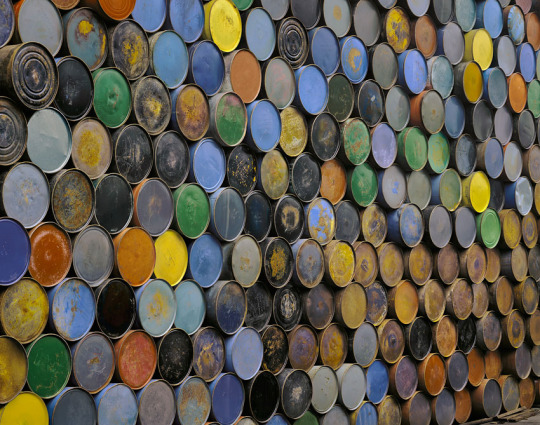
Wall of Drums, Seattle 2003
Another one of his photographs, container yard #3, also features similar compositional strategies, mainly extensive use of positive space, clustering and bleeding to add the impression of the mass amount of containers wasting away in this yard. He also effectively captured the alignment of these containers, conveying how these man-made structures are negatively effecting our natural environment. Jordan expanded on this idea by describing these shipping containers as appearing like “eroded layers in the Grand Canyon” and he found that the scene appeared like a “slow-motion apocalypse in progress” which he successfully conveyed through his photograph composition.

Container yard #3, Seattle 2004
Mandy Barker is a photographer whose main subject matter is marine plastic debris. The aim of her work is to raise awareness about plastic pollution in the ocean and highlighting the harmful affect it has on marine life and our society. Barker’s photograph series SHOAL focuses on debris collected from the 2011 Japan tsunami. Objects include plastic, shoes, cups, syringes, coat hangers and hats. She then arranged these objects into formations based on different species of fish that the debris has affected. This means that composition is vital to Barker’s practice, as the arrangement of the items in her works are strongly symbolic and supportive to her message as she explains “objects and particles have been duplicated to represent both the scale of lives lost and the amount of plastic that entered the ocean as a result of this natural disaster.”
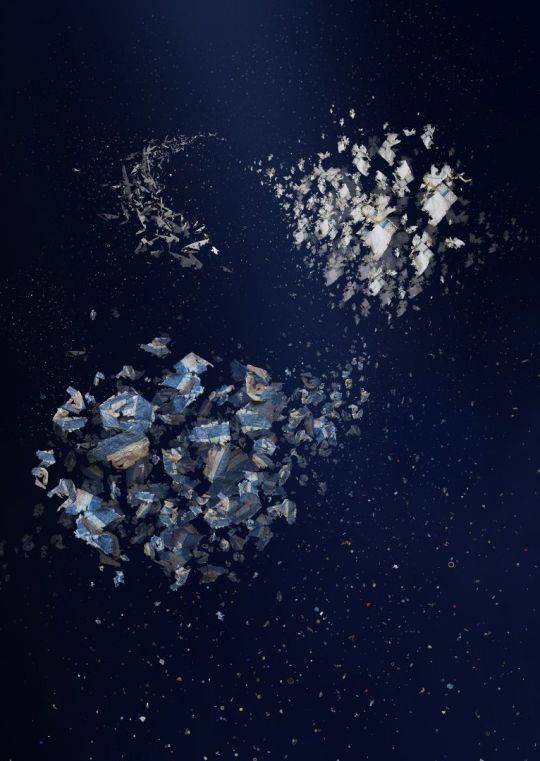
30.27N, 163.28E (Included: 3 pieces of plastic bag)
0 notes
Text
Hyperallergic: A Buenos Aires Museum Creates a New Lexicon for Latin American Art
Yeguas del Apocalipsis, “Las Dos Fridas (The Two Fridas)” (1989) (all images courtesy Museo de Arte Latinoamericano de Buenos Aires)
BUENOS AIRES — It’s impossible to overlook León Ferrari’s “Hongo Nuclear (Mushroom Cloud)” (2006) upon entering the second floor gallery of the Latin American Art Museum of Buenos Aires (MALBA). Made of enamel, foam, rubber, wire, and painted charcoal, Ferrari’s cloud is arresting in its size and literal in its subject: a memory of an atomic bomb that few global citizens can ever forget.
Installation view of Leon Ferrari’s “Hongo Nuclear” (2006) (photo by the author for Hyperallergic)
Ferrari’s mushroom is a violent, political addition to Verboámerica, the latest iteration of MALBA’s permanent collection. Reorganizing both iconic works and new donations made by founder and benefactor Eduardo Costantini, Verboámerica presents some 170 works that assign a new context for Latin American art and its movements.
The reorganization of MALBA’s permanent collection celebrates the museum’s 15th anniversary. Historian Andrea Giunta and MALBA’s artistic director Agustín Pérez Rubio embarked on a years-long research project that set out to repurpose the collection as a living history of Latin America. The resulting exhibition traces Latin America’s struggle for independence from its colonial past, while aiming to distinguish its artistic body of work from similar movements within the Western canon.
Installation view of Verboámerica at the Museo de Arte Latinoamericano de Buenos Aires
Instead of presenting the collection in a chronological fashion, Giunta and Rubio create a new lexicon with which to interpret Latin American art. Verboámerica breaks down Latin American art in the 20th century into keywords that are central to the region’s historical and social experiences — materiality, violence, migration, archives, politics, and narcotics — and traces how Latin American art has dismantled these power structures by challenging them systematically.
Several of the artists depart from traditional oil painting and experiment with materials as a way to articulate their critiques. Particularly, the artists draw on quotidian materials: Throughout Verboámerica, found objects, shape-shifting sculpture, and multimedia are tools to tackle the rippling effect of poverty and violence, the disorientation of migration, and the geopolitical implications of globalization.
Installation view of Verboámerica at the Museo de Arte Latinoamericano de Buenos Aires
Antonio Berni’s “La gran tentación o la gran ilusión (The Great Temptation or the Great Illusion)” (1962), a diptych illustrating icons of both poverty and wealth, embeds purse straps, rusted metal, and pieces of tin from Buenos Aires’ poorest neighborhoods into the canvas. Argentinian artist Jorge de la Vega‘s “El Dia Ilustrisimo (The Illustrious Day)” (1965) incorporates fabric, gemstones, and mirror glass on canvas, forming obscure, monstrous faces that evoke the silent ramifications of violence.
Nicolas Garcia Uriburu “Portfolio (Manifesto)” (1973) (photo by the author for Hyperallergic)
Violence is a consequence of migration, as Switzerland-born artist Claudia Andujar’s “Horizontal 3” (1981–1983/2015) points out. The series of photographs show indigenous peoples in Brazil with a number hanging around their necks, a mark of an NGO’s vaccination effort within the tribe. Anudjar organized the images into a grid as a symbol of the Western world’s attempt to ‘civilize’ native tribes.
Latin Americans have historically seen their economies, cultures, and art movements as inferior to their European and North American counterparts, as though the Latin American version were an inferior copy. The artists in this exhibition critically explore these assumptions. Peruvian artist Fernando Bryce, in “El Mundo Entero (The World Over)” (1929), produces a diagram that illustrates Latin America’s reliance on its northern counterparts, using maps and informational graphics detailing financial, agricultural, and industrial events that inevitably shaped Latin America’s dependence on globalism, such as Peru’s concessions to All American Cables, which strengthened the US communication company’s control over Latin American communications. Meanwhile, Uruguayan artist Joaquín Torres García‘s “Universalismo Constructivo (Constructive Universalism)” (1944) posits an inverted map of the Americas, taunting the viewer to consider a new world order.
Joaquín Torres García, “Universalismo Constructivo (Constructive Universalism)” (1944)
The use of otherwise categorical objects like maps and grids is a precursor to collage and archival photography as a means of political resistance, particularly among Argentine artists. Oscar Bony‘s portrait “La Familia Obrera (The Working-Class Family)” (1968) is an archival monument to the infamous performance piece, which paid a construction worker twice his usual salary to sit in a gallery for eight hours a day with his family, while sounds from their home life echoed in the background. Santiago Porter‘s “Evita” (2008), a portrait of a headless statue of Argentina’s former First Lady who was mutilated during a 1955 military coup, is part of a larger series in which the artist photographs and documents iconic historical monuments that unravel Buenos Aires’ sordid history.
Notably, dictatorships throughout the region spawned subversive groups that organized platforms for the marginalized. Chilean artist collective Yeguas del Apocalipsis, active between 1987 and 1997 and arising out of the Pinochet military dictatorship, depicts the artists in drag in a reinvention of Frida Kahlo’s painting, “Las Dos Fridas (The Two Fridas)” (1989). In the black-and-white photograph of Pedro Lemebel and Francisco Casas, they are dressed in skirts with exposed chests, emblazoned with a human heart and linked with a single vein. “Las Dos Fridas” references the militant homophobia that lingered during the transition of power from Chile’s dictatorship to a democratic society.
Lygia Clark’s “Bichos” (1960)
Verboámerica also touches upon artists’ experimentation with drugs and art, similar to the European Op and kinetic movements. In Latin America, artists like Julio Le Parc and Lygia Clark reasoned that narcotics and contemporary art could offer similar psychedelic experiences by creating moving objects and interactive sculptures. In Verboámerica, Argentine-born Le Parc’s “Trames Alterees (Universes in Universes)” (1968) is displayed along with two objects from Brazilian artist Lygia Clark’s “Bichos” (1960) series; both artists work with aluminum and create works that move and shift according to the viewer’s perception and interaction with the work.
Though once dismissed by the European and North American art world, Latin American art has steadily emerged as worthy of circulation, and Verboámerica declares that acquiescence. By underscoring the region’s artistic history and unique vocabulary, a visually stunning narrative springs to life.
Verboámerica is permanently installed at the Museo de Arte Latinoamericano de Buenos Aires (Av. Pres. Figueroa Alcorta 3415, C1425CLA CABA, Argentina).
The post A Buenos Aires Museum Creates a New Lexicon for Latin American Art appeared first on Hyperallergic.
from Hyperallergic http://ift.tt/2oVlyPh
via IFTTT
0 notes
Text
Interview with Scott Weaver

(Photo: Wired)
This is the interview I did with Stick Art / Sculpture artist Scott Weaver (during my thesis days) last December 22, 2015. The interview was over the phone (I was calling from the Philippines) and it was a really great experience for me especially because he was just so nice!
Where do you get your inspiration, especially when thinking of ideas for your work?
As a kid, I always loved building stuff and I have a lot of time to myself so I really loved drawing and building things out of small things. So when my teacher showed us how to build little toothpick sculptures, I really got hooked on it and loved it. And I went home and started building my own. And then it became bigger and bigger. And then I put a Ping-Pong ball in my sculpture, and the balls rolled a little bit and then I just made it—everyday I’d go on a couple of foot higher and I’d loved doing it.
Do you have a certain process that you follow when planning and/or doing your installations?
There are many different processes that I use. Sometimes I have to build structural-like-engineering-type-stuff to hold the sculpture, like placing. And then sometimes I work on a project away from the sculpture and build it aside from the sculpture and then install it a couple of days later or a couple of weeks later, once it’s done. So over the years, I’ve developed different kinds of triangles, engineering with arches, to do different forms of structure and if I’m planning something, I make, I try—everything is not in scale so it’s kind of whimsical. So it’s kind of fun—I don’t use any measuring as far as like a bridge being the side it should be for a building—it’s all kind of cartoony. So there are no rules when I do it.
What are the usual problems that you encounter in creating your sculptures, and how do you solve them?
Sometimes I run into problems where I'm trying to make the ball roll kinetically because the function of the kinetic part aspect of the sculpture with the balls rolling through, I need to make sure that one area is bigger and higher than the other in order to get the ball into a certain area so when I run into a problem where it won’t work, I have to re-structure or cut a hole into one of the main beams or something of the sculpture, but that’s kind of fun because there's no rules and I can do that by cutting a hole and then re-structure around that to make it strong all the way around so that there could be a pathway going through any part of the sculpture which helps a lot because some mediums like you do, like ceramics—you can’t really change things—with toothpicks, you’re able to change things and it makes it really inviting for me because I can build anything I feel. (Laughs)
Do you use a specific kind of stick/material in building your work? What made you interested in this kind of stick/material?
It’s all toothpicks. Everything is toothpicks. The toothpicks that I used I get from different places but for the whole outline part of it, the whole structure is made of toothpicks—some might be different brands, people bring me toothpicks from all over the world because I like to use different types. But for the most part, they’re all toothpicks.
Like for your (recent) project, Weaver’s Winter Wonderland, there are a lot of people that are intrigued by your work. How do you invoke your audience’s feeling of intrigue?
The people that respond to the Christmas thing every night is really wonderful, but the toothpicks, people think I’m an engineering genius. (Laughs) They just love it. They go “Oh my God, this is the most amazing thing that I’ve seen in the world!” People can’t believe that I’ve spent 41 years of my life building one piece of art. And that’s the fun part of it. There are times where I would work on it for days or weeks and other times I wouldn’t touch it for a long, long time like for a year because I have a wife and a son. There’s a big Exploratorium in San Francisco and when people come there from all over the world and they see me there and I roll the balls down, they go “Oh my God, what gave you the inspiration?” When they’re intrigued by it and they loved it so much, it just drives me to want to build more. Because I love making people happy, I love making people use their imagination and what could be made out of toothpicks. It’s just a small tiny piece of wood that we use to clean our teeth and people go “Oh my God, you made this big, giant”—it's 9 feet tall and 9 feet wide and 3 feet 6 so it’s like the size of 5 refrigerators, that’s like the analogy is. And people from all over the world just really enjoy the fact that it really looks beautiful like San Francisco, but then all of a sudden you put balls in 15 holes and they roll through it, they’re like “Oh my God, what kind of like a crazy man” but that’s what makes it fun—it’s when I took a small household item and no one would think that they can make something fun out of and make something beautiful that actually works.
Are you familiar with the picture book “Where The Wild Things Are” by Maurice Sendak?
I do remember “Where The Wild Things Are”. But, I never read it or saw it.
If the book would be involved with mixed media art, do you think Paper Twine and Toothpicks suit the picture book “Where The Wild Things Are”?
Let’s see, Paper Twine and Toothpicks. You’ll be doing it, building it on a piece of something? Yeah, that sounds neat. That sounds really neat that you’re going to do that.
Do you know any other artists who are also into these kinds of mediums?
Yeah. Not paper twine, I never used paper twine. But there’s a guy named Stan Munro from Syracuse, New York—he built a thing called Toothpick City, he’s an amazing guy, well, friend. There’s also a guy who built a 25-foot Queen Mary ship out of toothpicks named Wayne Kusy. But for some reason, I’m the only one that we’ve been able to find out that builds toothpick sculptures that have balls roll through them. Did you see any of the videos of the balls rolling? That’s what makes it fun. Kids love it when the balls rolling in.
Some of these new stories came out wrong. Five generations of our family grew up in San Francisco. My great-grandfather came from Italy to San Francisco and so my mom was born and raised there, my grandparents were there. And so there are parts of the sculpture—there’s a house--my mom’s house, my grandparents’ house, 5-18-12th Avenue, which is the house that my mom was born in, is in the sculpture. And the Ferry Building—the clock tower on the lower left corner, that clock tower has the time my mom was born on it, my life was born on it and the time my wife was born on it. So people really love the aspect that I included those times of birth, makes it personal.
#janinasart#artleast#please give credit#scott weaver#san fran#ferry building#san francisco#stick art#stick sculpture#toothpick sculpture#rolling through the bay#the tinkering studio#exploratorium#art#illustration#sculpture#ping-pong balls#balls#artist#phone interview#interview#article#thesis
0 notes